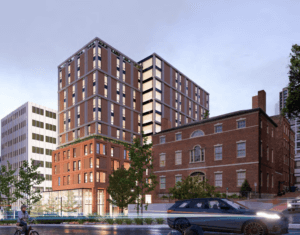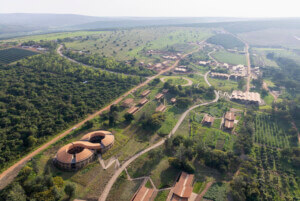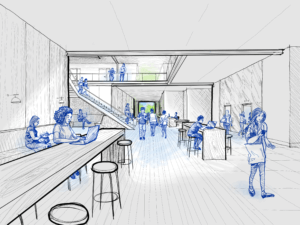This article will run in AN’s June/July issue, which will be published online later this week.
The term “turbulent zone” entered architect Paul Lewis’s vocabulary during the early days of the COVID-19 lockdown. It had nothing to do with meteorology or protests, but came to mind as Lewis, a principal at New York City-based LTL Architects, began a new research project on the challenges of urban mobility and physical distancing amid the pandemic. At grocery store entrances and other busy thresholds, he noticed, people were queuing up along the sidewalk, dutifully standing several feet apart—and creating a hazard for passersby who also wanted to keep their distance.
“Pedestrian flow up and down the sidewalk is always compromised at the door, which is why commercial entrances are recessed. But now that is exacerbated by more waiting in line, more pickups, and more deliveries coming out. All these activities are being pushed into that threshold and spilling back out to the sidewalk,” said Lewis. “We’ve been calling these areas ‘turbulent zones.’”
Lewis is one of a number of quick-thinking architects, designers, planners, curators, and theorists who are undertaking new research to figure out how architecture and design can respond to the COVID-19 crisis. While some urbanists have been criticized for seizing on the lockdown as a springboard for long-standing pet stratagems, these practitioners are attempting to place their creative skills in service to society, at times focusing on the needs of vulnerable populations. They are asking how buildings and cities may need to change in the wake of this pandemic, with an eye to the potential threat of future pandemics.
Retrofitting healthcare spaces
One of the most immediate, practical kinds of research involves rethinking the design of hospitals and pop-up urgent-care facilities, especially in hard-hit urban areas. Boston and Kigali, Rwanda–based MASS Design Group, an architecture firm that has worked on healthcare and infectious disease treatment facilities in Rwanda and Haiti as well as the U.S., has taken the logical but unusual step of partnering with healthcare providers to collect data on how treatment spaces perform under the pressure of a pandemic.
“Design professionals are not at the table all the time, so having those close relationships to be called upon and respond quickly to is a role that the spatial disciplines should be engaging more directly with in future,” said Michael Murphy, founding principal of MASS.
In late March, preparing for a surge in COVID-19 cases, Dr. John Bucuvalas, a senior physician and professor at Mount Sinai Health System in New York City, reached out to MASS, with which he had previously collaborated. He wanted help in studying a series of emergency spatial design modifications that the hospital had already begun to implement, including retrofitting an entire unit and constructing a 68-bed temporary facility in Central Park. MASS in turn brought in Ariadne Labs, a Boston-based health systems research center with which it had coauthored a study on childbirth facilities.“In healthcare, being intentional about the built environment is sort of a new idea,” said Dr. Neel Shah, a director at Ariadne Labs, in a May 12 virtual roundtable discussion hosted by MASS. “Within three days, we were doing the project, which involved letting the architects peer into Mount Sinai using a GoPro camera and Zoom conferencing,” added Bucuvalas. This was MASS’s second COVID-19-related undertaking, after it advised on the construction of two emergency tent structures for Boston Health Care for the Homeless Program back in March.
Over the course of three weeks, as Mount Sinai went into overdrive treating COVID-19 patients, the team carried out joint research with the aim of bringing challenges to light, identifying effective interventions, proposing a new framework to guide future retrofit and design efforts, and sharing lessons with other hospitals. In addition to poring over video footage, the architects interviewed frontline workers and asked them to color-code floorplans to indicate which areas were infectious or relatively safe.
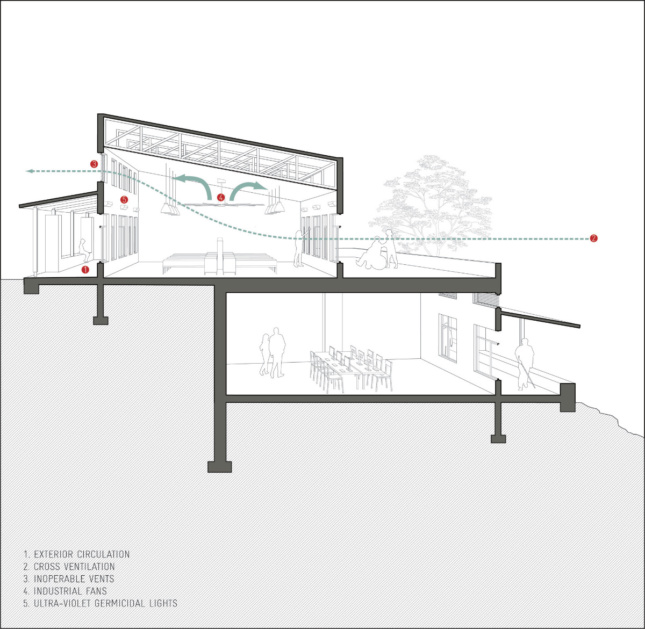
MASS’s resulting report reveals the challenges of trying to adapt idealized infection protocols to the non-ideal spaces of an overextended urban hospital. It documents interventions such as makeshift negative-pressure isolation rooms, HEPA filters in each room set up to vent waste air directly out the window, IV fluid dispensers and monitors placed in hallways, risk zones identified only by colored tape or film, and designated spaces for donning and doffing personal protective equipment. “Spatial design and awareness can mitigate risk,” the report states, but because “hospitals are implementing spatial redesigns on the fly,” they may be putting healthcare workers and communities at increased risk.
The report says more research is needed, but it offers several preliminary conclusions: First, enforcing infection protocol in hallways and unit entryways may be as vital as in patient rooms. Second, frontline workers show inconsistent perceptions of risk zones within care units, which could raise their odds of catching or spreading the virus. Finally, visual aids and “design nudges,” such as colored markings, can help health workers quickly understand risk zones and perform their duties safely. Amie Shao, a principal at MASS, said the next step is to create a “learning consortium” among health institutions to prepare for future pandemics and thereby help the institutions go “from impacting hundreds of people to potentially impacting millions.”
Rethinking everyday realms
Another important area of design research concerns the adaptation of everyday realms such as streets, plazas, shops, restaurants, transit stations, parks, and workplaces to the exigencies of distancing. The recent protests against police violence have shown that public space remains vital to democracy and the pursuit of social justice and that systemic racism has long represented a public health crisis. Both the coronavirus and the killing of George Floyd have provoked demands, in differing terms, for safer public spaces.
Gehl, a planning and placemaking firm based in Copenhagen, Denmark, gathers data on the use of public space to persuade city administrators worldwide to build walkable, bicycle-friendly streets dotted with urban furniture. It completed two ambitious surveys during the lockdown. “How do we actively invite people back to public space in a way that is comfortable, safe, and healthy, but also recognizes local conditions or restrictions?” asked Jeff Risom, partner and chief innovation officer at Gehl. “I like to see data. [With it] you can either confirm or bust myths.”
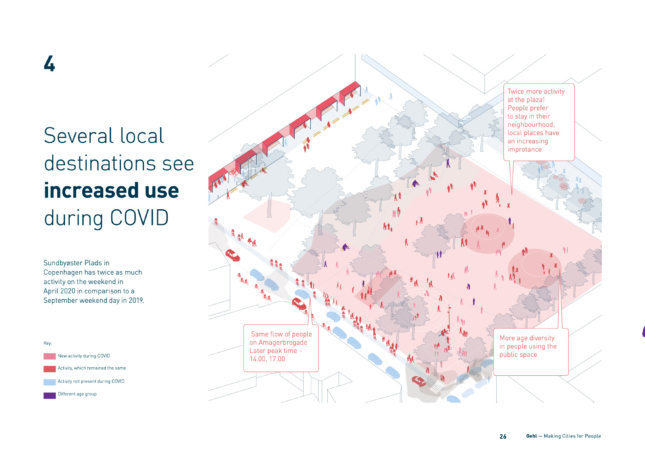
With the help of 60 surveyors and a custom-developed digital tool, Gehl observed public life in four cities in Denmark in April 2020. The firm’s report offers several “snapshots,” or first impressions, of how people were using public spaces under the altered circumstances, including novel behaviors and differences between how women and men tend to use public space socially or alone. The report concludes with ten questions to prompt future design innovations, such as “Which street types, features, and their programming are more conducive” to public life in a pandemic?
Gehl also conducted a global online survey investigating altered relationships to public space during lockdown. Of the more than 2,000 people from 68 countries and 40 U.S. states who responded, approximately one-third stayed at home except for essential errands, while those who did venture outside “relied heavily” on nearby streets, parks, and front stoops. “If safely and creatively reimagined, designed, and managed, our public spaces can be community lifelines—for improving access to essential resources, keeping people fit, and reducing isolation,” the firm wrote in a summary of the survey results.
In New York City, architect Paul Lewis, engineer Guy Nordenson, and staff members from their respective firms have begun research on a project funded by a grant from Princeton University. “One of the things that we’re trying to do is to make legible some of the issues at play both at the urban scale and at the individual body scale,” Lewis said of the ongoing effort. (In early June, Lewis et al. published a draft of the project under the title “Manual of Urban Distance: Strategies for Reconfiguring the City.”) Working primarily in isometric view to show measurements in three dimensions, the team has been drawing scenarios to reveal the difficulties and contingencies involved in pedestrians navigating typical city streets while maintaining a safe distance from each other. Part of the problem is that neither the U.S. Centers for Disease Control and Prevention’s six-foot benchmark nor other guidelines proposed in peer-reviewed scientific journals is appropriate to every situation, and they do not account for variable fresh-air circulation or duration of exposure. “It’s not some magical distance,” Lewis observed. “It’s actually a gradient of potential concern or risk. So how do we even map that?”

As the team’s preliminary studies show, to maintain a healthy distance from each other, pedestrians on a crowded Manhattan street (100 people per block) would have to move almost in lockstep, i.e., at the same velocity and in only one direction along each side of the street. Perhaps walking and cycling space could be expanded, pavement could be painted, and street furniture could create a buffer between people moving in opposite directions. But even if New Yorkers could be induced to adopt such a robotic march, Lewis’s associate Anna Knoell said, they would still veer into each other’s space to avoid obstacles like kiosks, tree pits, construction scaffolding, and leashed dogs. Add in the “turbulent zones” of commercial building entrances with lines stretching down the block, and keeping one’s distance in public is impossible. “Storefronts are harder to negotiate,” Lewis noted, “whereas stoops are allowing a kind of return of social activity because they provide some distance.”
School architects, too, are contemplating how to transform learning spaces in anticipation of students’ eventual return. Rather than simply biding time until schools can reopen in their familiar form, educators should confront the difficult question of why school must exist as a physical space, rather than as a series of remotely accessible virtual lessons, suggested Prakash Nair and Roni Zimmer Doctori, the founder and chief architect, respectively, of Education Design International. “Good schools … [offer] opportunities students could never get at home,” they write in a white paper addressing school design in a post-pandemic world. “We now have an opportunity to retool and reenergize schools and schooling so that it looks very different than the place we all learned in with rows upon rows of classrooms, each with one teacher gamely struggling to impart ‘knowledge’ to an increasingly disinterested audience.”
Fomenting conversation and debate
Fresh research is also emanating from the curators, professors, and critics who interpret and sometimes set the agenda for architectural practice. Paola Antonelli, curator of architecture and design at the Museum of Modern Art (MoMA), and Alice Rawsthorn, a design critic based in London, teamed up in April to create Design Emergency, a series of interviews and case studies exploring designers’ responses to the current pandemic.
“Our mission is to disseminate the importance and power of design,” Antonelli said. “With COVID-19, we have seen amazing contributions, and we decided it would be wonderful to talk about them.”
Design Emergency exists primarily as an Instagram account (with over 8,500 followers at press time) that broadcasts weekly live interviews with designers who are responding to COVID-19, plus images captioned with curatorial remarks. The smart, concise writing recalls a “daily diary on design,” an Instagram series by Rawsthorn that has some 70,000 followers, and the subject matter revisits themes from Antonelli’s 2005 MoMA exhibition SAFE: Design Takes on Risk. Interview guests to date include medical illustrator Alissa Eckert, information designer Federica Fragapane, architect Michael Murphy, and product designer Dries Verbruggen.
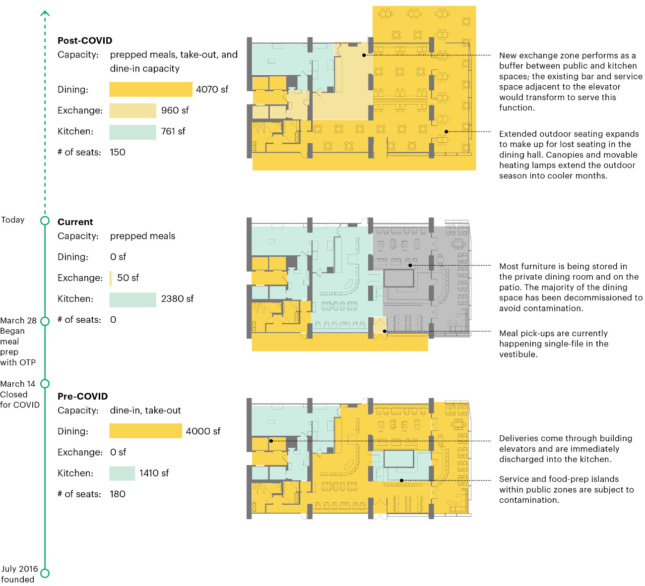
The transatlantic collaborators are planning to publish a Design Emergency book consisting of 25 or so case studies. For now, they are toeing the line between formal and informal media and knowledge production, pairing unfiltered live-streamed interviews from home with meticulous copy and a slick graphic identity designed by Studio Frith. Their decision to self-publish on Instagram allows them to experiment and see immediate results, in keeping with the improvisational ethos of “hacking” that Antonelli and Rawsthorn discussed during their May 21 broadcast. A “hacked design project,” they wrote in a May 19 post, is one that, designed professionally or otherwise, “reinvents existing objects, technologies, components, environments, customs, skills or anything else,” as exemplified by projects such as an emergency ventilator made out of repurposed components from a Toyota Corolla, designed by five teenage girls in Afghanistan.
The term “hack” was pejorative before it was cool, and to some audiences, it may undermine the value of quick, temporary, and informal design innovations, said Faiza Moatasim, an assistant professor in urbanism and urban design at the University of Southern California School of Architecture. “There’s a hierarchy built into this term. Why ‘design hacks’ versus just ‘design’?”
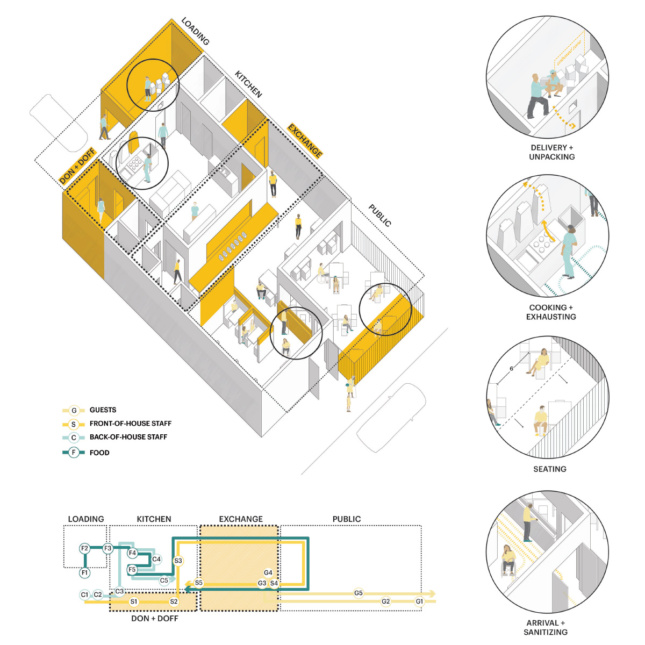
Moatasim’s ongoing research on informal urbanism and temporary spaces leads her nonetheless to agree with the gist of what Antonelli and Rawsthorn are pointing out, with potential consequences for city life. “The difference between formal and informal realms in urban design does not exist anymore. The two are entwined. Governments and planners use informal and improvisational strategies to design and develop cities, while street hawkers and squatters engage with formal systems to survive. This is already happening in cities across the global south, but I think we are now going to see more improvisational urbanism here in the U.S.”
As evidence, Moatasim cited the temporary markings and retrofits seen in hospitals and shops and on streets and sidewalks in the wake of COVID-19. “The exciting thing is that sometimes these temporary measures can lead to a meaningful impact in the long term,” she said.
Makeshift and experimental solutions, seen as prototypes, can drive better design in the future. Ideas can come from anyone or anywhere, but smart and equitable design research requires asking good questions, listening, and observing carefully, and working collaboratively. If necessity is the mother of invention, it is also the progenitor of research, invention’s quiet but indispensable sibling.







